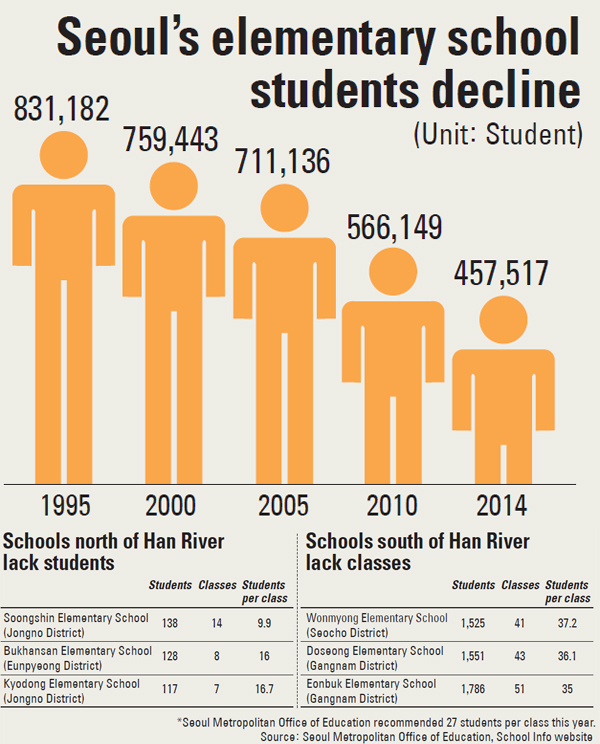Schools merge after a decline in students

The proposal was finalized on Monday by the Seoul Metropolitan Office of Education, the city’s education authority. Sinheung Elementary School and Heungil Elementary School in Geumcheon District, southwestern Seoul, which are only 300 meters (984 feet) apart, will be the first to combine their students.
The number of children at Sinheung Elementary School has declined by 37 percent over the past four years, from 615 students across 24 classes to 389 students in 18 classes. Heungil saw a similar decrease in the same period, from 589 to 431.
“A drop in birth rate naturally shrinks the number of students, but the decline here seems to be faster than that of Gangnam District,” said Shin In-su, the principal of Sinheung Elementary School. “It’s partly because there are not many large-scale apartment complexes here.”
The number of students per class has also dropped. Sinheung Elementary School currently has three classes per grade, with the average number of students per class at 21.6.
Many of the students stay in the same class year after year, giving them less opportunity to socialize with their other classmates.
The two schools decided on June 27 that they would merge in March. Students from Heungil Elementary School will move to Sinheung Elementary School, which will change its name to Seoul Sinheung Elementary School.
Hanul Middle School, 3 kilometers (2 miles) away, will then take the compound that was formerly Heungil Elementary School. That move will meet the demands of local parents, who complained over the lack of a middle school in the area.
“The students who are actually moving are relatively more nervous,” said Kim Gap-cheol, the principal of Heungil Elementary School. “So we are planning to hold a joint talent show in the next semester.”
The plan is an education milestone, marking the first merger of two schools in a large city due to a decreasing number of students.
In Seoul, the number of students dropped to 457,517 this year, down from 831,282 in 1995. The number of elementary schools, however, has increased, to 599 this year from 512 over the same period, according to the education authority.
But analysts say that there could be more instances in which mergers make sense. Kyodong Elementary School in Jongno District, central Seoul, admitted only 21 new students this year, for instance, and considered closing down. The school currently has 117 students in seven classes.
According to education experts, elementary schools located near old housing complexes tend to suffer more, and many have considered merging or closing down altogether.
Those who live in older residences tend to stay there longer, causing the number of students in such areas to naturally fall.
Right now, Kongjin Elementary School and Gonghang Elementary School have plans to move to a newly developed town in the same district.
“Elementary schools in hollowing out downtown areas, such as Jongno District and Jung District, are likely to face mergers in the future,” said Ahn Deok-ho, the head of the school support department at the Seoul Metropolitan Office of Education.
“But because most schools meet the local education authority’s recommendation, [which is to have 27 or more students per class], such merges are not going to happen anytime soon.”
There is also a gap among schools located north and south of Han River in terms of the number of students per class.
There were fewer students per class in elementary schools on the north side of the city, like in Jongno District (21.2), Yongsan District (22.7) and Jung Distrct (23), than in schools in Seocho District (27.1), Gangnam District (25.6) and Songpa District (25.3).
On the south side, Wonmyong Elementary School in Seocho District had 1,525 students across 41 classes - or 37.2 students per class - outnumbering the recommended level by more than 10, while Soongshin Elementary School in Jongno District, north of the Han, only had 138 students in 14 classes, or 9.9 students per class.
Right now, Ahn said, “we are trying to establish guidelines to select schools to merge based on examples from suburban areas in Korea.”
BY KIM KI-HWAN AND SHIN JIN [bongmoon@joongang.co.kr]










with the Korea JoongAng Daily
To write comments, please log in to one of the accounts.
Standards Board Policy (0/250자)